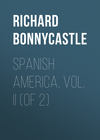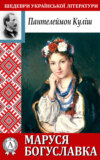Kitabı oku: «Spanish America, Vol. II (of 2)», sayfa 19
THE PROVINCE OF COLCHAGUA
Is situated between the Cachapoal on the north, the Andes on the east, the Pacific on the west, and the Teno river on the south. Near the Andes its breadth is twenty-five leagues, but on the coast it does not exceed fourteen, while its length, from east to west, is forty-three.
Its climate is temperate, the soil fertile, and, being well watered by numerous rivers, produces grain, wine and fruits. Here are several gold mines, and it is not wanting in other metallic substances. This province was formed out of part of the country of the Promaucians, who vigorously repelled the attempts of the first conquerors: but having been compelled to make peace they have ever since been the faithful allies of the Spaniards, and the enemies of the people of Arauco.
Their name signifies the Nation of the Country of Delight, in the Chilese language, as they were so called by the other tribes, on account of the beauty of the territory they inhabited.
The principal rivers are the Rio Claro, Tinguiririca, Chimbarongo, Teno and Nilahue, and it contains several lakes, of which Taguatagua and Caguil are the largest; the former is noted for the abundance of water-fowl which frequent numerous beautiful islands in it, and for its trout. This lake is fourteen leagues from Santiago, on the shore of the Tinguiririca. Caguil is small, and full of fish.
The capital and chief towns are St. Fernando, Rio Clarillo, Roma, Malloa, Topocalma and Navidad.
St. Fernando, the capital, is in 34° 18' south latitude, near Rio Tinguiririca; it was built in 1742, and contains about 1500 families, with a parish church, a Franciscan convent, and a college, with a handsome church built by the Jesuits.
Topocalma is a port at the mouth of the river of the same name, which passes near the city of Santiago, and discharges itself into the ocean in 33° 31' south latitude.
Rapel is a settlement near Lake Rapel, a sheet of water formed by the sea. This village is noted for having a hill in its vicinity in which is a singular cavern, consisting of a single vault, fifteen yards long, and from three to four wide, to which there is a natural door-way two yards high. The other towns are of no note.
PROVINCE OF MAULE
This partido is bounded on the north by Colchagua, on the east by the Andes, on the south-east by Chillan, south-west by Itata, and on the west by the Pacific. It is forty-four leagues in length, and forty in breadth, and, like the preceding, having formed part of Promaucia, is a delightful country, abounding in grain, fruits, cattle, sea and river fish, salt and gold; and the cheese made in Maule is esteemed the best in Chili.
It is watered by many rivers, of which the Lantue, Rioclara, Panque, Lircay, Huenchullami, Putugan, Achiguema, Longavi, Loncamilla, Purapel, Mataquito, Liguay and Maule are the largest.
The inhabitants of this fine province are mostly Promaucian Indians, who are tributary to the Spaniards, and live in villages governed by their ulmens or caciques.
The great volcano of Peteroa is on its eastern border, amid the Andes, and is the most dreadful of all Chilian volcanoes. Its greatest eruption happened on the 3rd of December, 1760, when it formed itself a new crater. Peteroa is 105 miles south-south-east of Santiago, 192 north-east of Concepcion, in 34° 53' south latitude; and 60° 49' west longitude.
The capital of this district is Talca, or St. Augustin, founded, in 1742, in 35° 13' south latitude, and 71° 1' west longitude, 193 miles north-north-east of Concepcion, and 105 south of Santiago, on the shore of the river Maule. In its vicinity to the east is a fort to restrain the incursions of the Indians, and to the north-east is a small hill, which furnishes abundance of amethysts, and another which consists of a singular cement sand, known by the name of talca.
Its population is considerable, owing to the rich mines of gold in the mountains, and to the low price of provisions, which has induced many families to leave the other towns, and settle in Talca. It contains a parish church, two monasteries, and a college built by the Jesuits, and in its immediate neighbourhood are two chapels of ease.
Maule contains several other towns, and large villages of Indians. Curico, Cauquenes, St. Saverio de Bella Isla, St. Antonio de la Florida, and Lora, are the principal ones.
Curico, or San Josef de Buena Vista, was built in 1742, on a fine plain at the foot of a hill, from which there is a good view, in 34° 14' south latitude, and has a parish church and two convents.
Cauquenes was built also in 1742, in 35° 40' south latitude, between the rivers Cauquenes and Tutuben. It has a church and convent.
St. Saverio and Florida were founded in 1735, the first in 35° 4', and the second in 35° 20' south latitude.
Lora, near the mouth of the Mataquito river, is a large village of the Promaucians, a courageous, robust and warlike race; and it is governed by an ulmen or chief.
The port of the province is Asterillo, a small bay between the Maule and the Metaquito rivers: but the province of Maule is now said to be divided into three parts; the part southward of the river Maule being named the partido of Cauquenes, that on the north Maule, and on the north-east, some lands in Colchagua having been annexed, it is called the partido of Curico, with the town of that name for its capital.
THE PROVINCE OF ITATA
Is bounded by Maule on the north, Chillan on the east, the Pacific on the west, and Puchacay on the south. From east to west its length is twenty leagues, and its breadth from north to south eleven.
The river Itata intersecting this department, it had its name from it, and the only other stream of note is the Lonquen.
The fertility of Itata is such that it produces the best wine in Chili; which wine is called Concepcion, from its being made on the estates of persons belonging to that city. The sands of the rivers above-named, contain gold, and some is also found in its mountains.
The capital of Itata is Coulemu, in 36° 2' south latitude, but it is merely a small place founded in 1743.
THE PROVINCE OF CHILLAN
Is bounded on the north by Maule, east by the Andes, west by Itata, and south by Huilquilemu. Its length is twelve leagues, and breadth twenty-five, and the whole district till it reaches the Andes is a plain, in which immense flocks of sheep are fed, that are highly esteemed on account of their fine wool. The soil being very fertile produces corn and fruits in abundance.
Its chief rivers are the Cato, Nuble, and Chillan, and on its eastern border is the great volcano, which bears the name of the district.
The capital, St. Bartolomeo de Chillan, was founded in 1580 on the river of the same name, in 36° south latitude, and has been frequently disturbed and destroyed by the inroads of the Araucanians; in the year 1751 it was destroyed by an overflow of the Chillan, and in consequence, it was removed to its present scite, which is a short distance from where it first stood, and less exposed to the inundations of the river in winter. This city has a numerous population, one parish church, three convents, and a college founded by the Jesuits, 75 miles north-east of Concepcion.
THE PROVINCE OF PUCHACAY
Is bounded on the north by Itata, on the east by Huilquilemu, on the west by the ocean, and on the south by the river Biobio, being twelve leagues in extent from north to south, and twenty-three from east to west.
Puchacay is noted for the abundance of gold found in it, and for the fertility of its soil; its large wild and garden strawberries are much sought after for making preserves.
The Lirquen the Andalien, and the Biobio are its finest rivers.
The capital is Gualqui, founded in 1754, upon the north shore of the Biobio, in 36° 44' south latitude, and in which the Intendant or prefect usually resides; but the city of Concepcion is the most important town in the province.
Conception, or Penco was founded by Valdivia in a valley on the sea-coast in 36° 47' south latitude, and 73° 9' west longitude; at the commencement it flourished very much, owing to the predilection which the founder had for it, and to the quantities of gold discovered in its vicinity, but after the battle of Mariqueno in 1554, Villagran the governor abandoned the place and it was burnt by Lautaro the Araucanian toqui; it was however rebuilt in November 1555, but Lautro returning with a great force took it, slew the inhabitants, and once more destroyed the town; Don Garcia de Mendoza restored it and fortified it so strongly that it was enabled to resist a siege by the Indians for fifty days; but Concepcion was doomed to be again taken and burnt by them in 1603.
The consequence of the harbour to the Spaniards, and the necessity of having a strong town on the frontier, caused it to be once more rebuilt, and as every means to increase its natural strength was taken, it soon became formidable enough to defy the Indians. This city continued to increase till 1730, when it was almost totally destroyed by an earthquake and inundation.
It was again rebuilt, but in 1751 another earthquake, attended with a still more dreadful inundation, destroyed it totally. The inhabitants fled to the hills, and continued in an unsettled state for thirteen years, when they resolved to build their favourite city a league from its former scite, in a beautiful valley named Mocha. Concepcion was erected into a bishopric after the total destruction of the city of Imperial in 1603.
The corregidor of Penco is commander of the army on the Araucanian frontier, and assembles the militia when ordered out at this place. There are also several public offices in Concepcion, viz. the royal treasury for the payment of the troops; the camp master general's office, &c. The royal audience was first established there in 1567, but was afterwards removed to Santiago.
Besides the palace of the captain-general who is obliged to reside at Concepcion occasionally, it contains a cathedral, convents of all the religious orders established in Chili, a nunnery, a college founded by the Jesuits, public schools, and a seminary for the nobility.
The inhabitants amount to about 13,000; and the climate of this city is delightful, the temperature being always mild.
The bishop of Concepcion has a jurisdiction extending over all the islands and continental settlements of the Spaniards south of the province of Santiago; but what renders this city of the greatest importance, is its bay, which is one of the best in Spanish America. Its length from north to south is about three leagues and a-half, and the breadth from east to west three. In the mouth of it lies the island of Quiriquina, forming two entrances, of which that on the east is the best, being two miles broad.
In the bay are three anchoring grounds, that named Talcaguana is the most frequented by all vessels, as they lie secure from the north winds. It has a small town at its termination two leagues from the capital, and to which it gives its name; the two other roads are not so well sheltered from the north winds, and have not such good bottom as Talcaguana. The tides rise six feet three inches, but the water is smooth, and the current is scarcely felt. Though this celebrated harbour is so good, yet it is necessary to have an experienced pilot to conduct a ship into it, as there are several reefs and shoals off the entrance.
PROVINCE OF HUILQUILEMU
Huilquilemu is the thirteenth and last department of Continental Chili, and is bounded by Chillan on the north; by the Cordillera of the Andes on the west, Puchacay on the east, and the Biobio on the south.
The rivers Biobio, Puchacay, Itata, Claro, Laxo, and Duqueco are its chief streams, and the first named may be said to be the boundary between the Spanish possessions and the country of the Araucanian confederacy. It rises in the Andes near the volcano of Tucapel, and runs into the Pacific, a short distance south of the city of Concepcion, where at a league above its mouth it is four leagues in breadth. The Biobio may be forded on horseback in summer, but in winter it is deep, and generally navigated with balsas or rafts. On the northern and southern shores of this river, the Spaniards have constructed a chain of frontier forts to restrain the Indians; these works are generally strongly built, and well furnished with arms, ammunition, provisions, and a competent garrison of cavalry, infantry, and artillery.
The principal forts are Arauco, where the commanding general resides, Santajuana, Puren, Los Angelos, Tucapel, Yumbel, Santabarbara, St. Pedro, Nascimiento and Colcura.
Huilquilemu is rich in gold, which is procured by washings in the numerous streams flowing from the Andes; its plains are very fertile, and yield grains and fruits in great plenty, and an excellent muscadel wine is made from the vines grown in its settlements.
The Indians are of the same tribe with those of Itata, and having been long accustomed to defend their country against the Araucanians; they are warlike and courageous.
The capital is Estancia del Rey, or St. Luis de Gonzaga, lately built near the Biobio in 36° 45', south latitude. It has a parish church, and a college erected by the Jesuits. The other places of Huilquilemu, are mostly small villages, and it contains the four frontier forts, Yumbel, Tucapel, Santa Barbara and Puren.
The Spaniards possess no other part of Chili on the continent, in proceeding to the south of the Biobio river, till the 39° 58' of south latitude, where they hold the city of Valdivia and the country in its vicinity, but as their tenure is by no means certain without the walls of the town, it cannot be called a province.
Valdivia is situated on the banks of the river of the same name, in south latitude 40° 5', west longitude 80° 5', at three leagues distance from the sea.
This city was founded in 1551, by Pedro de Valdivia, who gave it his name, and amassed much gold in its vicinity, which tempted many Europeans to settle in it, so that it soon became a place of importance.
In 1599, it was surprised by the toqui Paillamachu, who entered it at night with 4000 men, slew the greater part of the garrison consisting of 800 soldiers, burnt the town, and carried the inhabitants into captivity. It was, however, soon rebuilt more strongly, and resisted all the attacks of the Araucanians, but was taken by the Dutch in 1640, who abandoned it soon after.
On the arrival of the Spanish fleet which had been fitted out to attack the Dutch garrison, they found Valdivia deserted, and therefore set immediately about adding to its fortifications, erecting four new forts on both sides of the river, towards the sea, and one on the north on the land front.
These precautions have prevented it from falling into the hands of the natives or foreigners, but it has been twice nearly destroyed by fire.
This town contains a college built by the Jesuits, several convents, a parochial church, and a royal hospital; and is governed by a military officer, nominated from Spain, who has a strong body of troops under his orders. The fortress is provisioned, by sea, from the ports of Chili, and the troops are paid by the treasury of Peru.
All the rivers in the vicinity of Valdivia contain much gold dust in their sands, and the plains furnish fine timber.
Its harbour is formed by a beautiful bay made by the river, which is navigable for large vessels a considerable distance from its mouth. The island of Manzera, lying in the entrance of the stream, divides it into two channels, which are bordered by steep mountains and strongly fortified.
The Spaniards not possessing any other settlements important enough to excite notice on the main land, towards the south, we shall pass to the description of their island territories in this quarter.
INSULAR CHILI
No part of America has more islands on its coasts than Chili has, and many of these being inhabited, they form a political as well as a natural division of the kingdom.
The following are the chief Chilian Isles: —
The three Coquimbanes, Mugillon, Totoral and Pajaro, which lie off the coast of Coquimbo, and are each six or eight miles in circumference, but are uninhabited.
Quiriquina, at the entrance of the harbour of Concepcion, and Talca, or Santa Maria to the south of the harbour, which are two islands of about four miles in length, noted for the abundance of shell fish and sea wolves found on their coasts. In Santa Maria there are also fine springs, and many wild horses and hogs, the latter of which feed on the wild turnips which cover its valleys.
Mocha, in 38° 40', is more than sixty miles in circumference, and lies off the coast of Araucania; is not inhabited, but is very fertile, and was formerly settled by some Spaniards; at present it is frequented by the whalers from the United States and England, who begin fishing here, as it is well supplied with wild hogs; but the most important of the Chilian group are the isles comprised in the —
ARCHIPELAGO OF CHILOE,
Which is an assemblage of islands, forty-seven in number, situated in a great bay or gulf, near the southern extremity of Chili, and extending from Cape Capitanes to Quillan, or from 41° 50' to 44° south latitude, and from 73° to 74° 20' west longitude.
Of this group thirty-two have been colonized by the Spaniards or Indians, and the rest are untenanted. The largest of those which are inhabited is Chiloe, or Isla Grande, which in former times was called Ancud, but has since given its present name to the whole group.
Chiloe is situated at the entrance of the gulf of Chiloe, or Ancud, having its western shore opposed to the continent, and forming a channel, which is about three miles broad at the north entrance, and twelve leagues at the south.
It lies between 41° 30' and 44° south latitude, being about sixty leagues in length and twenty in its greatest breadth.
The climate of this, and of all the others, is mild and salubrious, and the extremes of heat and cold are unknown. Unlike the northern provinces of Chili, the rains in Chiloe are so frequent that it is only in the autumn they discontinue, and that but for a short time. The air is, therefore, humid, and grain and fruits are not so abundantly produced as on the continent. The corn raised in Chiloe is however fully sufficient for the consumption of the inhabitants; and barley, beans and pease thrive very well. The vegetables principally cultivated, are cabbages and garlic; but the gardens do not produce much fruit; apples and some other hardy plants being the only ones which arrive to perfection.
Horses and cattle are bred in considerable numbers, as are sheep and swine; and in the two latter the commerce of the islanders principally consists.
Deer, otters and foxes are natural to the soil, and there is no want of game.
The seas around, and the streams which flow into them, swarm with fish of every kind; and the forests furnish abundance of timber fit for every purpose.
This group of islands was first discovered by Don Garcia de Mendoza, in his march to the south of Chili. In 1563, Don Martin Ruiz Gamboa was sent to conquer them with 60 men, and with this trifling force he subjected the Indians, amounting, it is said, to as many thousands. He founded the town of Castro and the port of Chacao in Chiloe. The Chilotes, or native Indians, remained quiet for a long time, but at last threw off the yoke of Spain; and Don Pedro Molina was then sent with a strong force from Concepcion, and soon reduced them to their former obedience. They are descendants of the Chilese of the continent, but far from resembling them in their warlike bent, are extremely timid and docile. The Chilotes are remarkable for their ingenuity, and are particularly capable of carrying on the trades of carpenters, joiners, cabinet-makers and turners. Their manufactures of cloths, linen and woollen, display much taste, and are dyed with beautiful colours.
The Chilotes are the best sailors in South America; their little barks, or Piraguas, are very numerous in the seas surrounding their island, and being navigated with sails as well as oars, give a lively appearance to the shores. In these barks, which only consist of a few planks sewed together and cauked with moss, they make voyages to Concepcion.
Besides the Chilotes, there are several other natives of different tribes in the islands, who have accompanied the missionaries from the neighbouring continent, and the Indian inhabitants of the Archipelago are said to amount to 11,000, divided into seventy-six settlements or districts, each governed by a native chief. The number of persons of Spanish descent is about the same, dispersed in farms, in small settlements, and in four towns.
The commerce of the Archipelago is carried on by a few vessels from Peru and Chili, which bring wine, brandy, tobacco, sugar, Paraguay tea, salt and European goods, and take in return red cedar and other boards, timber of different kinds, ponchos or cloaks manufactured by the Indians, hams, dried and salted fish, toys and ambergris; but their trade will probably never be very thriving, as the navigation of the numerous straits formed by the islands, is extremely difficult and dangerous for large vessels.
All the islands are mountainous and full of craggy and precipitous rocks, covered with impenetrable thickets, which render cultivation difficult, except in the valleys and on the shores; the interior is therefore seldom inhabited; on Chiloe there are forty settlements or townships, which are mostly on the coast. These townships have each their church or chapel, but the houses are very much dispersed.
Earthquakes are as frequent in these islands as on the mainland, and it does not appear by any means improbable, from the conic formation of most of the mountains, and their scorified appearance, that they are the produce of some dreadful internal convulsion, which has disrupted them from the adjacent continent, on which is the lofty snow-capped summit of the great Corcobado, and several active volcanoes; the range of the Cordillera approaching close to the coast in these latitudes.
In 1737, the Archipelago suffered very much from the effects of an earthquake, and the islands of the Guaytecas group to the south, were covered with ashes which destroyed the vegetation for thirteen years.
The continent opposite to the northern extremity of Chiloe, has some Spanish settlements in the country of the Canches and Huilliches, small but independent tribes; these settlements are said to be three in number, of which Fort Maullin, opposite to Chaco Bay in Chiloe is the chief, and the Spaniards are engaged in forming communications from this settlement to Valdivia; as the sea is rendered almost innavigable during the winter by the frequent and dreadful storms. Pedro de Agueros, gives the names of twenty-four islands on the east of the Great Chiloe, which are inhabited, but as so little is known concerning this group, and as several contradictory statements have been made about them, the mere names are uninteresting.
The capital is Castro, in 42° 40' south latitude, on the eastern shore of the island of Chiloe, upon an arm of the sea, and was founded in 1566, by Don Martin Ruiz de Gamboa.
The houses, as is the case with all the rest in the province, are of wood, and are inhabited by about 150 persons; it has a parish church, a convent of Franciscans, and another of Mercedarii, in which only two or three monks reside. This city was overthrown by an earthquake soon after its foundation, since which it has never been in a flourishing state; it is 180 miles south of Valdivia.
The other towns are the port of Chacao or Chaco, in the middle of the north coast of Chiloe, and opposite to Port Maullin, which has a tolerable anchorage, but is difficult of access.
San Carlos is on the Bahia del Rey, and was built In 1767, on account of the difficulties attending the entrance to Chaco. It is in 41° 57' south latitude, and 73° 58' west longitude, and is the most populous and flourishing town in the province, containing 1100 inhabitants. The harbour is good, but subject to tremendous squalls and hurricanes; and the town is fortified, and has a regular garrison; and from the advantages of its harbour, the governor and council always reside at San Carlos.
The other islands have each one settlement and a missionary church on them, excepting Quinchuan, which has six; Lemui and Llachi, each four, and Calbuco three, but none of any material consequence.
South of the Islands of Chiloe is the Archipelago of Guaytecas and Chonos, lying in a large gulf or inlet of the continent, from 44° 20' to 45° 46' south latitude; they are comprehended by the Spaniards within the province of Chiloe, but are uninhabited, being a mere mass of granite rocks, covered with thick forests.
Some of these, namely, Tequehuen, Ayaupa, Menchuan and Yquilao, the Indians of Chiloe visit periodically, and put cows in them, for the sake of the pasture, which is luxuriant.
Having now concluded the description of that part of Chili inhabited by Spaniards, and their descendants, we shall give a slight sketch of the country, reaching from the Biobio river to Fort Maullin; and which, on account of its being the territory of the Araucanians and of nations in confederacy and identified with those people, in manners and language, it may be proper to give the general name of Araucania.










